|
| |
Back to homebuilts
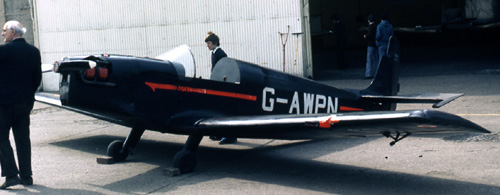 |
The Shield Xyla is a one off design by Gorge
Shield, who was headmaster of Mexborough Grammar School in
Yorkshire. It was built at the school, which shows a level of trust
in the pupils which would be hard to find these days! It first flew
in October 1971. Powered by a 65hp Continental engine, it cruises at
110mph and has a range of 500 miles.
It is seen here being prepared for a flight at
Doncaster, April 1977. |
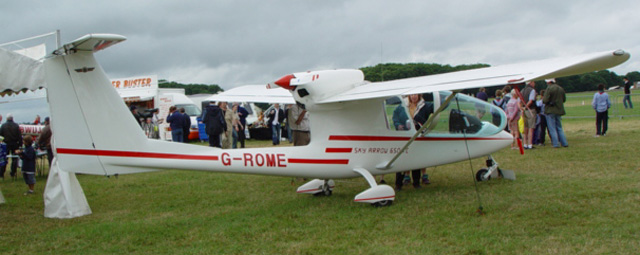 |
The Sky Arrow is a two seat tandem composite
machine built by Iniziative Industriali Italia SpA (formerly known
as Meteor SpA). It is available either as a factory-built or a kit
aircraft. It cruises at 110mph and has a range of 390 miles. There
are about 14 in the UK as of summer 2006. It is 24 feet 9 inches
long and has a wing span of 31 feet 5 inches. Kemble,
July 2005 |
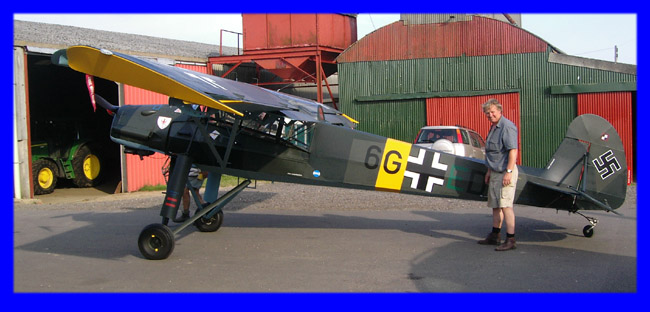 |
The Slepcev Storch is a 75% scale replica of the
German wartime Fiesler Storch, designed in Switzerland by Nestor
Slepcev. The visual effect is faithful and the build quality
excellent, but it is better on the ground
than in the air; a Storch needs a growling Argus inline (or a radial
if you have a Morane-Saulnier version), and this one has a
high-revving, whining Rotax! It cruises at a stately 85mph (pretty
comfortable when you reflect that the stalling speed is only just
over 35mph). It is a very unusual machine, ideal for someone with a
flair for the historical, a sense of individuality, and a great deal
of patience!
Top Farm, July 2005 |
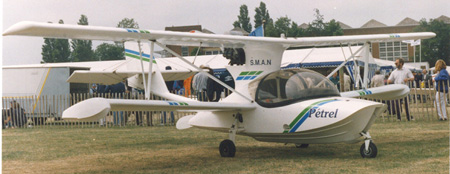 |
One of a small number of homebuilt
amphibians, the SMAN Petrel is a little two seat composite floating
biplane powered by a Rotax engine. SMAN stands for Societe
Morbihannaise d'Aero Navigation ... no wonder they abbreviated it.
This picture was taken at
Cranfield, date uncertain |
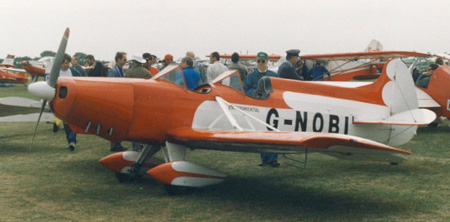 |
The Spezio Tuholer was designed by Tony
Spezio and first flew in May 1961. The `proper' name is Spezio Sport
DAL-1, but with the cockpit looking like two holes, the nickname
stuck. It is a very economical machine, with a metal tube fuselage
and wooden wings all covered with fabric, powered by a 125hp
Lycoming engine, which enables it to cruise at 120mph. It is 18 feet
long, with a wing span of only 24 feet.
Cranfield, date uncertain |
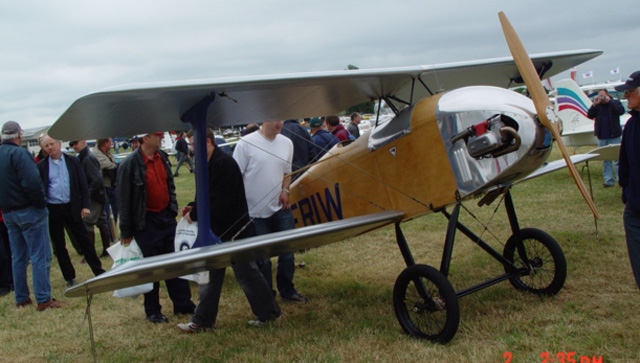 |
The Staaken Flitzer was designed by Llyn
Williams(www.flitzer.btinternet.co.uk),
to represent a hypothetical World War One fighter. The Staaken name
is unrelated to the famous German pioneering aviation company. It is
mainly made of wood and fabric, and is powered by a 65hp converted
Volkswagen engine. This gives it a cruising speed of 85mph and range
of 300 miles. It is a very small single seater, with gross weight of
only 750lb, 14 feet 9 inches long, with a wing span of 18 feet.
This is a rather poor picture, taken at
Kemble in July 2005; there were no moments in the day when it was
not surrounded by onlookers! |
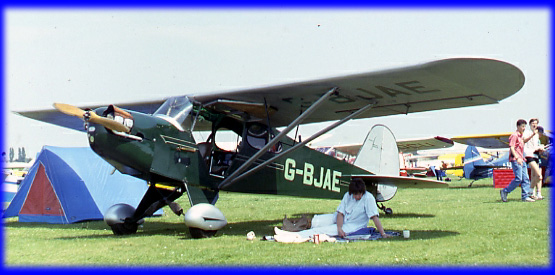 |
The Starck AS80 Holiday was designed in 1947
by French designer Andre Starck. It is a two seater in a similar
class to the Piper Cub; its 75hp Regnier engine enables it to cruise
at 90mph, and it has a range of 200 miles. Gross weight is 1,210lb;
it is 21 feet 5 inches long and has a wing span of 32 feet 5 inches.
This one visited
Cranfield, July 1987 |
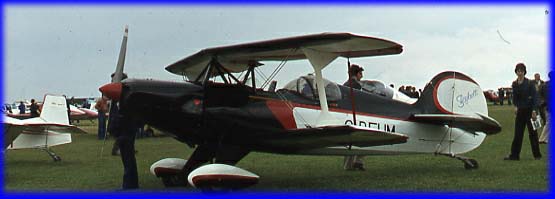 |
The Steen Skybolt is a two seat high
performance aerobatic biplane designed by Lamar Steen in the USA and
first flown in October 1970. It is larger than the superficially
similar Pitts Special, so is preferred by larger pilots. Plans are
available from www.steenaero.com.
It has conventional construction - metal tube fuselage, wooden wings
and fabric covering. It can be powered by any suitable engine,
normally a Lycoming ranging from 180 to over 300 hp. It `cruises'
(if any pilot can ever bring himself not to do aerobatics in it) at
over 150mph. It is 19 feet long, with a wing span (upper) of 24
feet, and gross weight of 1,800lb.
Cranfield, July 1980 |
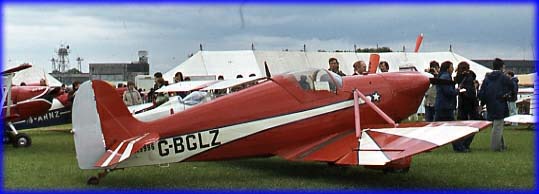
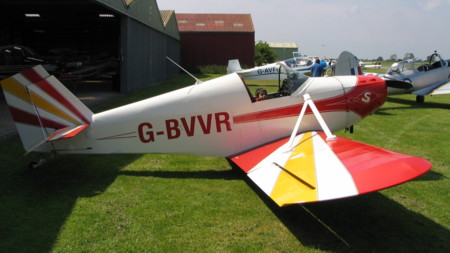 |
The Stits Playboy is a 940lb single seater
designed in the USA by Ray Stits, and first flown in 1952. The
fuselage is made of metal tube with wooden wings, the whole covered
with fabric. This one is powered by a Continental C-90 engine, but
other engines can be used: for example, a 125hp engine gives it a
cruising speed of 120mph. It is 18 feet long, with a wing span of 23
feet.
Top:
Cranfield, July 1980 Bottom: Breighton,
June 2007 (someone little being allowed to sit in the cockpit to
make up for bumping his leg while helping to move the Chipmunk,
behind, so the owner could get the Playboy out). |
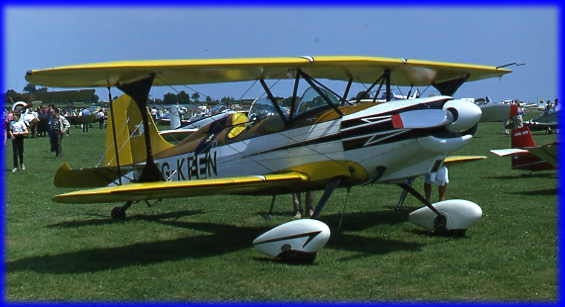 |
The Stolp Starduster Too is a two seat
aerobatic biplane, reminiscent of the Pitts Special, but noticeably
larger. It was designed by Californian designer Louis Stolp, who
flew his prototype in 1957. It is a very agile aircraft with crisp,
powerful control. Like the Pitts Special, it is normally powered by
a Lycoming 180hp engine. Length is 20 feet, wing span 24 feet and
maximum takeoff weight 1,980lb. Top speed is 210mph and range 830
miles. 15 are currently registered in
the UK (as of October 2005), including this one, pictured at
Cranfield in July 1983. |
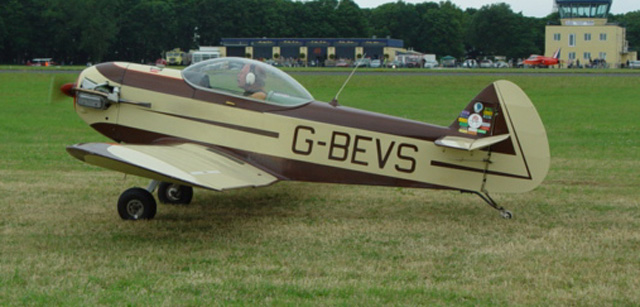 |
The Taylor JT1 Monoplane is a wooden single
seat aircraft designed for amateur construction by John Taylor, and
first flown from White Waltham in 1959. It is a very small aircraft:
length is only 15 feet and wing span 21 feet. Maximum weight is
660lb. It cruises at 90mph for a range of 300 miles. A variety of
engines can be installed; this one, built in 1978 and seen at Kemble
in July 2005, has a 1,834cc Volkswagen engine. 33 were registered in
the UK in October 2005. |
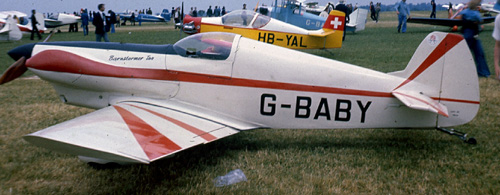 |
The Taylor JT2 Titch is a diminutive single
seater, just over 16 feet long and having a wing span of 18 feet 9
inches, which can reach a top speed of 180mph on the power of an
85hp Continental engine. Like the JT1, it was designed by John
Taylor.
This one was at
Leicester, July 1980 |
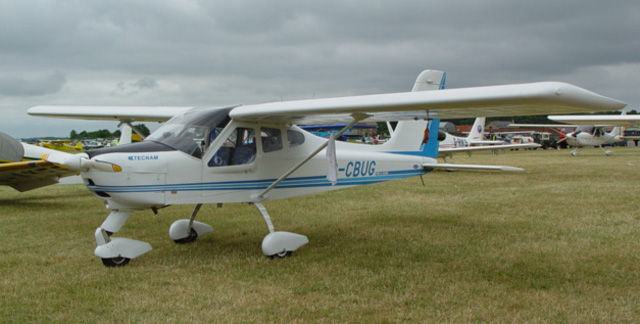 |
The Tecnam Echo is one of the newer kit
aircraft, designed in Italy but now marketed worldwide (see, for
example,
www.tecnamaircraft.com). Its 100hp Rotax 912 engine gives it a
cruising speed of 130mph. It is a two seater, with a gross weight of
1,290lb, length of 21 feet, and wing span of 28 feet 6 inches.
Kemble, July 2005 |
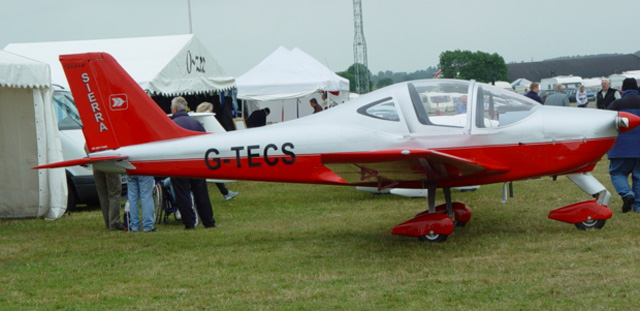 |
The Tecnam Sierra is another design following
similar principles to the Echo, being mostly aluminium with a few
fibreglass mouldings. On the same engine, it cruises 10mph faster
than the Echo. Gross weight is the same as the Echo, and dimensions
are similar, length being 21 feet 8 inches, and wing span 28 feet 2
inches.
Kemble, July 2005 |
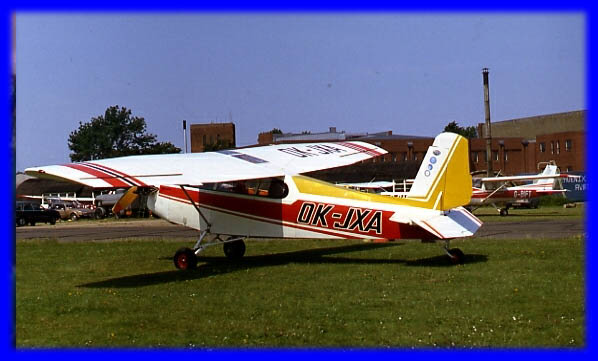 |
The Trempik SK1 is one of the very first
Czech homebuilt aircraft. It is a one off design by Jan Simunek.
Unfortunately I know very little else about it.
It visited
Cranfield in July 1983. |
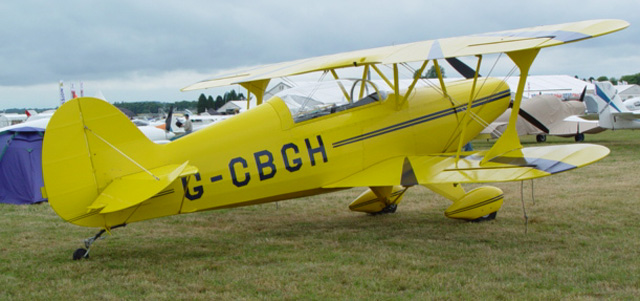 |
The Teverson Bisport is a one-off
modification of the Steen Skybolt, designed and built by Richard
Teverson in the UK. The aim was to reduce the landing speed to make
it more suitable to operate from short strips, and cover the two
seats with a single piece canopy. It is a delightful and beautifully
crafted machine, which was pictured at
Kemble in July 2005 |
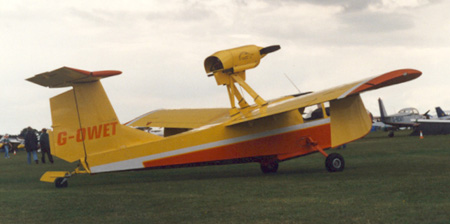 |
The Thurston Teal is a two seat all metal
amphibian which first flew in June 1968. Interestingly, the engine
is mounted with the propeller facing forwards (in contrast to the
Lake LA-4 or Volmer Sportsman). Its 150hp Lycoming O-320 engine
gives it a cruising speed of 110mph and range of over 500 miles.
This suitably registered example was pictured
at an uncertain location, but it looks suspiciously like Cranfield. |
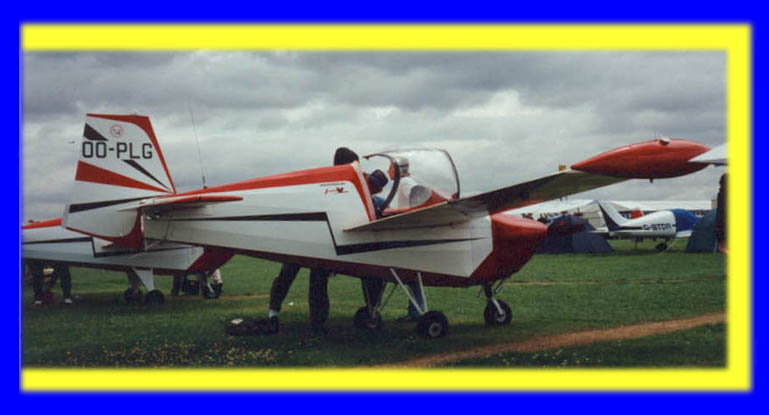 |
The Tipsy Nipper is a minuscule single seater
designed by Belgian designer E.O. Tips, and initially built by the
Belgian Tipsy comany, who imported about 14 to Britain in the 1960s.
It is very agile, and described by David's father's cousin as `the
only aircraft I've ever taken off in and done three rolls before
reaching the end of the runway!' Its shoulder mounted wing gives
excellent all-round visibility but makes it quite tricky to get into
or out of. The design was adopted by Slingsby, the Yorkshire-based
glider makers, who built just over 30 at their Kirkbymoorside works.
Plans are available for home builders, with whom it is quite popular
due to its simple construction of fabric over steel tube; about nine
homebuilt examples are currently active in the UK. Length is
only 14 feet 9 inches, wing span 19 feet 8 inches and maximum weight
725lb. It will cruise at 90mph for up to 200 miles.
This Belgian registered example was at Cranfield
in 1998. |





|